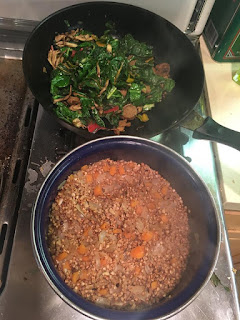I love, love, love Ethiopian food! I was introduced to it in the early 1990s, when my aunt Michal, a social worker, flew out to Addis Ababa to bring Ethiopian Jews safely to Israel in Operation Solomon. After the newcomers settled in their new home, my aunt continued to work with the community. She was among the first non-Ethiopian Israelis to speak fluent Amharic, and she made plenty of friends in the community. Because of that, we ended up invited to lots of feasts and weddings, and after suspiciously eyeing the injera, I tried a bite or two.
Or a hundred. It was so good!
Several wonderful Ethiopian-Israeli restaurateurs, including my friend Imanuel from military service, opened Ethiopian restaurants all over the country, and I loved eating there. My favorite was Habash. I was so happy, upon moving to the Bay Area, to find two of my favorite eateries: Cafe Colucci in Oakland and Cafe Ethiopia here in the Mission District. But as of today, if you fancy some vegan Ethiopian delicacies, venture no farther than Casa Corazones, because I just cooked my first Ethiopian feast!
Clockwise, from top left:
- ye’atakilt alicha (stewed cabbage, potatoes, and carrots in mild sauce)
- ye’misser wot be’ingudai (lentils with mushrooms in spicy sauce)
- kale and vegetable salad
- gomen be’telba (greens in toasted flax seed sauce.)
Really, really, REALLY good.
I hesitate to reproduce the full recipes, because I would much rather you went and bought Teff Love, the fabulous cookbook where I got them with lots of tips and good information. The book is super authentic in that it walks you, step-by-step, through toasting and grinding your own Ethiopian spices and sauce bases. They are complex and exotic to taste, but made of surprisingly common ingredients I already had in my kitchen. Happily, my friend Dena is here on a visit and brought me berbere spice, but you can make your own. I did toast and grind my own flax seeds, as well as made my own flavored oil and also ye’wot qimen, a black-pepper and warming spices blend. Here’s the recipe for the spice blend:
1 teaspoon oil
3 tbsp whole black peppercorns
1 tsp whole cloves
1 tbsp whole nigella seeds
1/2 tsp husked green cardamom seeds
1/2 tsp whole cumin seeds
2 tsp cinnamon
1/2 tsp nutmeg
Heat oil in small skillet and add all ingredients except the cinnamon and nutmeg. Toast and stir for a few minutes until fragrant. Remove from heat, mix with cinnamon and nutmeg, and let rest in a cool plate. Once cool, process to a fine powder in an electric grinder. Stor in a jar for up to 4 weeks.






